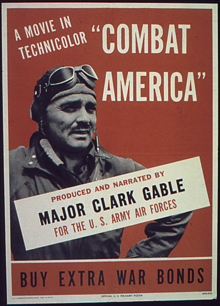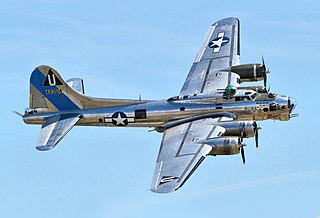
The Boeing B-17 Flying Fortress is a four-engined heavy bomber developed in the 1930s for the United States Army Air Corps (USAAC). Relatively fast and high-flying for a bomber of its era, the B-17 was used primarily in the European Theater of Operations and dropped more bombs than any other aircraft during World War II. It is the third-most produced bomber of all time, behind the four-engined Consolidated B-24 Liberator and the multirole, twin-engined Junkers Ju 88. It was also employed as a transport, antisubmarine aircraft, drone controller, and search-and-rescue aircraft.

The Aerial Gunner Badge was a military aeronautical badge of the United States Army Air Forces and was issued during the Second World War. The badge was first created and authorized on April 29, 1943 to recognize both the training and hazardous duty of aerial gunners, who manned defensive machineguns on board such aircraft as the B-17, B-24, B-25, B-26 and B-29 bombers. The Aerial Gunner Badge appeared as a standard observer badge, upon which was centered a winged bullet. It was primarily awarded to USAAF enlisted aircrewmen, but a small number of commissioned officers also qualified and were awarded this insignia, to include film actor Clark Gable.

General Ira Clarence Eaker was a general of the United States Army Air Forces during World War II. Eaker, as second-in-command of the prospective Eighth Air Force, was sent to England to form and organize its bomber command. While he struggled to build up airpower in England, the organization of the Army Air Forces evolved and he was named commander of the Eighth Air Force on December 1, 1942.

Royal Air Force Station Polebrook or more simply RAF Polebrook is a former Royal Air Force station located 3.5 miles (5.6 km) east-south-east of Oundle, at Polebrook, Northamptonshire, England. The airfield was built on Rothschild estate land starting in August 1940.

Maynard Harrison "Snuffy" Smith was a United States Army Air Forces staff sergeant and aerial gunner aboard a B-17 Flying Fortress bomber in World War II, received the Medal of Honor for his conduct during a bombing mission over France on May 1, 1943. Smith was the first enlisted member of the United States Army Air Forces to earn the Medal of Honor.

Frank Alton Armstrong Jr. was a lieutenant general of the United States Air Force. As a brigadier general in the United States Army Air Forces during World War II, he was the inspiration for the main character in the novel and subsequent film, Twelve O'Clock High. After the war, he held a variety of senior leadership positions prior to and following the establishment of the USAF as an independent service in 1947. Promoted to major general in 1950, he advanced to lieutenant general in 1956 and retired at that rank in 1961.

Frederick Walker Castle was a general officer in the U.S. Army Air Forces during World War II, and a recipient of the Medal of Honor. He was killed in action leading the bombing mission for which he was awarded the Medal of Honor.

The Memphis Belle: A Story of a Flying Fortress is a 1944 documentary film which provides an account of the final mission of the crew of the Memphis Belle, a Boeing B-17 Flying Fortress. In May 1943 it became the third U.S. Army Air Forces heavy bomber to complete 25 missions over Europe, but the first to return to the United States.

The Memphis Belle is a Boeing B-17F Flying Fortress used during the Second World War that inspired the making of two motion pictures: a 1944 documentary film, Memphis Belle: A Story of a Flying Fortress and the 1990 Hollywood feature film, Memphis Belle. It was one of the first United States Army Air Forces B-17 heavy bombers to complete 25 combat missions, after which the aircrew returned with the bomber to the United States to sell war bonds. In 2005 restoration began on the Memphis Belle at the National Museum of the United States Air Force at Wright-Patterson AFB in Dayton, Ohio where, since May 2018, it has been on display. The B-17 used in the 1990 feature film is housed at the National Warplane Museum in Geneseo, New York.

Royal Air Force Grafton Underwood or more simply RAF Grafton Underwood is a former Royal Air Force station located 4 miles (6.4 km) northeast of Kettering, Northamptonshire, England.

The 351st Missile Wing is an inactive United States Air Force unit, which was last based at Whiteman Air Force Base, Missouri. Assigned to Strategic Air Command for most of its existence, the wing maintained LGM-30F Minuteman II ICBMs in a state of readiness to fire, pursuant to any launch orders that might be received from the National Command Authority. It was inactivated in 1995.
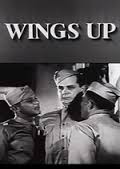
Wings Up is a short propaganda film produced during World War II, highlighting the role of the United States Army Air Forces Officer Candidate School. The film emphasized that while usually these courses would take up to a year in college, the country was at war now and needed all the qualified officers it could get and fast. The curriculum is briefly outlined in Wings Up as well as the kind of life a student would lead at this training center.

Beyond the Line of Duty is a 1942 American short propaganda film, directed by Lewis Seiler. The documentary film reenacted the life and career of United States Army Air Corps Captain Hewitt T. "Shorty" Wheless.

The 97th Operations Group is a United States Air Force unit assigned to the 97th Air Mobility Wing of Air Education and Training Command. It is stationed at Altus Air Force Base, Oklahoma.

The 509th Missile Squadron is an inactive United States Air Force unit. It was last assigned to the 351st Operations Group at Whiteman Air Force Base, Missouri. The squadron was equipped with the LGM-30F Minuteman II Intercontinental ballistic missile with a mission of nuclear deterrence. With the end of the Cold War, the 509th was inactivated on 28 July 1995.
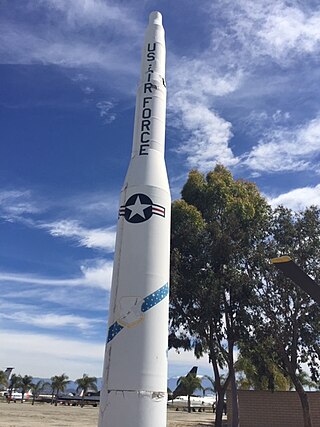
The 510th Missile Squadron is an inactive United States Air Force unit. It was last assigned to the 351st Operations Group at Whiteman Air Force Base, Missouri. The squadron was equipped with the LGM-30F Minuteman II Intercontinental ballistic missile with a mission of nuclear deterrence. With the end of the Cold War, the 510th was inactivated on 15 November 1993.

The 511th Bombardment Squadron is an inactive United States Air Force unit. It was last assigned to the 351st Bombardment Group at Fairfax Field, Kansas, where it was inactivated on 27 June 1949.

Fortress is a 2012 war film directed by Michael R. Phillips and stars Bug Hall, Donnie Jeffcoat, Sean McGowan and Joseph Williamson. The film was released by Bayou Pictures and although initially intended for wider release, was a direct-to-video release on July 31, 2012 made by Monarch Video. Fortress takes its name from the iconic Boeing B-17 Flying Fortress World War II bomber that was the centerpiece of the aerial battle in Europe.

Army Air Forces Gunnery Schools were World War II organizations for training personnel in the skill of aerial gunnery. The several schools existed at domestic Army Airfields and gunnery ranges.
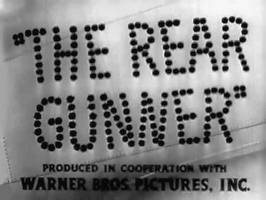
The Rear Gunner is a 1943 American short instructional film, directed by Ray Enright and produced by Warner Brothers. Previously, Warner Bros. had produced three short documentary films, Winning Your Wings (1942) starring Jimmy Stewart, Men Of The Sky (1942) and Beyond the Line of Duty (1942).
